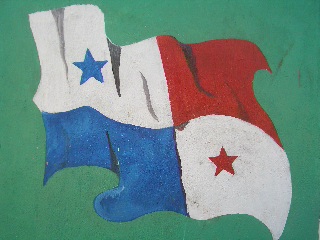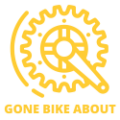
Dec 29 – Jan 22, 2007
Cartagena (Colombia) – San Blas Islands – Panama City – Santiago – Chiriquí – Bocas del Toro – Guabito
Panama, renowned for its canal and straw hats, was our entry point to Central America. Having reached the end of the line in Cartagena, Colombia, we decided to sail across the Caribbean and arrive in style.

Considering our sailing knowledge is limited to feeding fish, we got ourselves a captain, a chef and a 49-ft sail boat. On the seas for 4 years from their home in Quebec, we reckoned, we were in safe hands with Gaétan and Marianne. And so we were.
Choosing a sail boat/crew can be tricky business. There are lots of cowboys out there willing to overcrowd a dodgy bathtub and rake in the cash. Many of our friends had a 5-day trip turn into a 2-week ordeal due to vessel complications. On Alegría II it was a different story, luxurious plain sailing with a crew second to none.
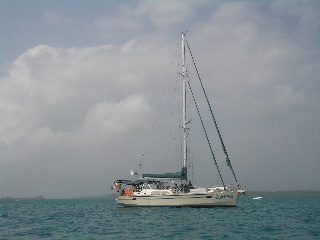
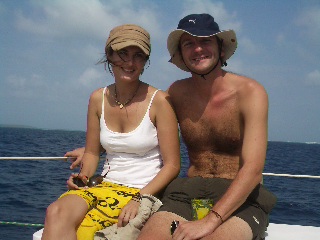
We sailed for 36 hours on opensea in the pleasant company of fellow passengers Caroline (Scotland) and Rik (England). We all managed to contribute to the feeding of fish at one stage or another, but on the whole had a calm crossing.
On New Years Eve morning we arrived at the San Blas archipelago. 365 islands dotted in tranquil turquoise waters (just like Clew Bay, Co. Mayo!) make San Blas yet another picture postcard paradise.
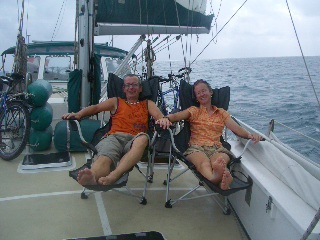

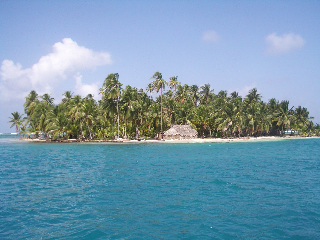
There are two types of islands: Those planted with coconut palms and surrounded by white sand beaches…
… and those filled with bamboo huts and surrounded by traditional toilets on stilts!

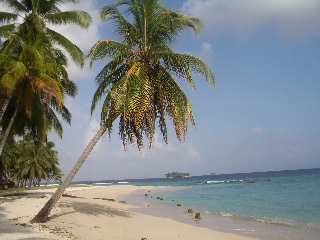
The palm-studded sandbanks are wonderful for chilling out and offer great snorkelling opportunities in the nearby reefs.
The inhabited islands offer basic accommodation on hammocks in bamboo huts with dirt floors.
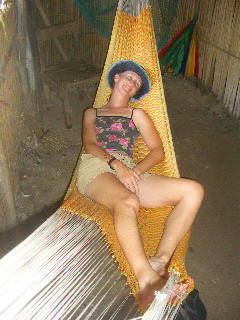
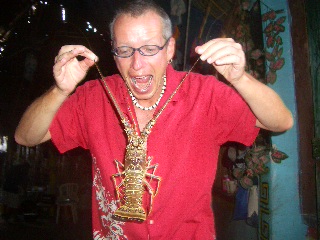
On the culinary line, it can be feast or a famine. Food depends on the fisherman’s goodwill, and can vary from horrendous canned sardines to delicious freshly-cooked lobster and crab.
But, it’s the toilet that causes most amusement. Having walked the plank to the cubicle straddling the water, a mouldy wooden throne-like structure awaits, while fish swim below in anticipation of the daily downloads!
A coconut shell and a bucket of water replace both the toilet paper and the shower. Tourists approach these contraptions with their own personal style varying from the western sit down position, the full squat and the half squat… to total abstinence for the duration of their stay!
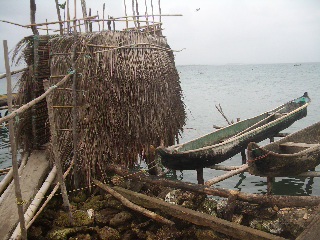
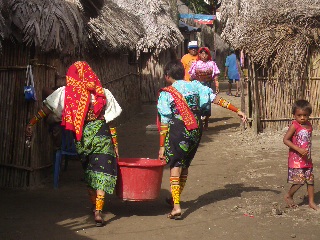
The San Blas Islands are home to the Kuna tribe. This indigenous group still dresses in traditional costume and follows their ancestral lifestyle, having won autonomy from Panama in 1925.
The ladies wear appliquéd mola blouses, red and yellow headdress’, colourful sarongs and interesting beading on their arms and legs. They often have extravagant gold nose rings and necklaces and why shouldn’t they? It’s them that call the shots. Women own the coconut trees and the houses and send the men out to work.
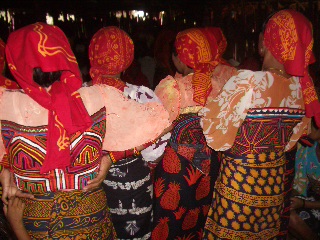
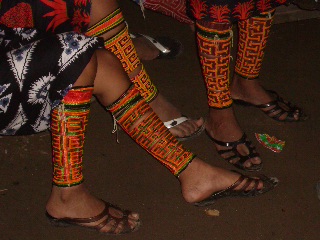
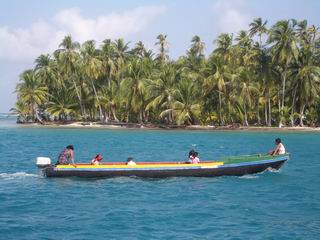
Fishing from cayucos (dugout canoes) and counting coconuts seems to be the men’s daily business;
…meanwhile the women stitch their molas while trading valuable local gossip.
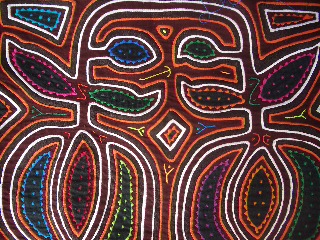
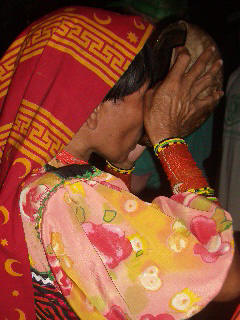
We stayed on one such island for a couple of days and were invited to a huge ceremony in honour of a young girl having reached puberty. This entailed the consumption of gallons of chicha (fermented sugarcane juice mixed with coffee) while stamping around in a ritual fashion. The chanting and laughter of very merry men and women filled the ceremonial hut for hours on end.
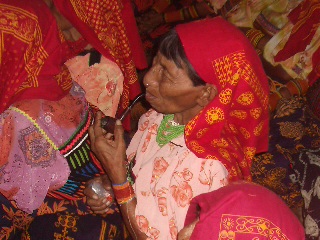
Once stamped in on Porvenir Island, when the Immigration office finally opened after their Christmas/New Year break, we cycled up and down the runway in the hope of flagging down a plane.
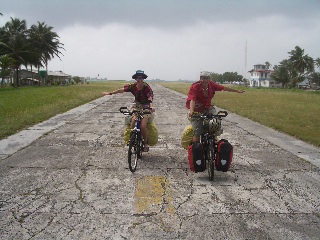
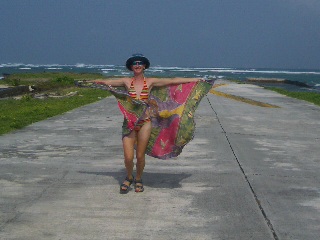
Alas, the first three chicken chasers were full to the brim. Darina had a word with one of the pilots and lo and behold, he was back with an empty plane within the hour! He jumped out, lit a fag and announced: If you can get your bikes in there, I’ll bring you to Panama City!
So, we gave Kurt a leg up into the hold where he squeezed the bikes in, in bits and pieces and we were off! It turned out to be quite a mail run and we touched down on many islands before making it to the big city.

Aeroperlas luggage allowance of 15kg would only cover our bikes and not our other 60kg but they were so distracted by our reassembly performance at the airport, nothing was weighed and nothing was charged!

Ahh! Panama city! What a dramatic change from the simple beauty of the San Blas Islands to the simple beauty of air-con shopping malls!
This city is a little like Colombia! You choose the altitude you wish to live at; we chose the fourth floor! An impressive skyline marks its Pacific shoreline and McDonalds team with Dunkin Donuts, KFC and Subway to complete the picture.
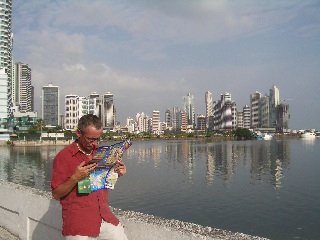
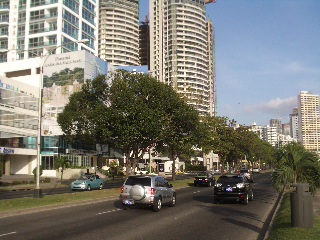
The unusual absence of traffic lights in this city of 1.5 million had us standing meekly on the side of a 6-lane street waiting patiently for an opportunity to cross. On the other side of the street a local lad wondered if we were standing there for the good of our health and shook his head disapprovingly.
Introducing us to the Panamanian way he boldly walked out into the centre of the busy street, stopped all traffic and waved us across with the authority of a traffic warden. Welcome to Panama!
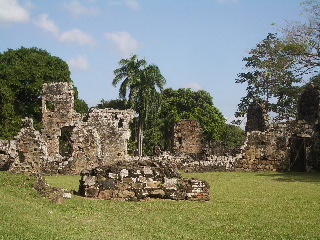

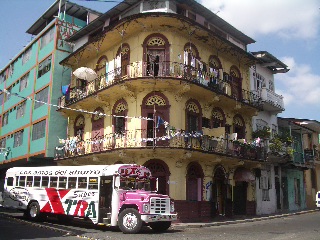
A lot of renovation work has been done on some of the colonial buildings of this casco antiguo…
…but a good 10 years of work would be required to restore the magnificent architecture of the good old days.
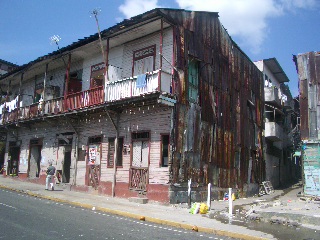

The Chinese have been here for 150 years and we were very happy to restock our supply of dried mushrooms and spices in Chinatown. Later, the Chinese mini markets along the highway made for great pit stops in the suffocating heat.
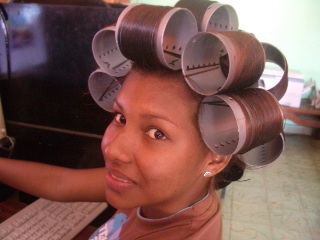
Of course, the main tourist attraction in Panama is the Panama Canal. Panama owes its independence from Colombia to the USA’s desire to build the canal and deal with a smaller state for the right to do so. This huge engineering project to join the Pacific and Atlantic Oceans took 10 years to complete, with the first boat passing through in 1914.

Boats have to be lifted through a series of locks to reach the altitude of an artificial lake and then be dropped again on the other side to sea level. At the Miraflores locks we were fascinated by the proceedings as these huge container ships were lifted/lowered to the next level.
The main shipping route that benefits from the canal is from Asia to East Coast USA. US companies account for almost 70% of the traffic, followed by China, Japan and Chile. The average fare for a container ship is about $280,000 to cross this 80km waterway. We could fill you with statistics of the canal, but the most interesting trivia is that no less than 50 Farrells sacrificed blood, sweat and tears in the building of this 8th wonder of the world.
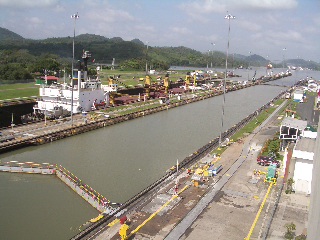
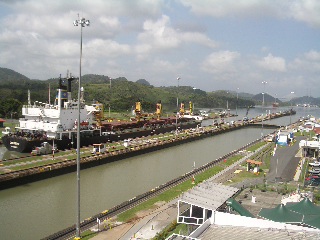
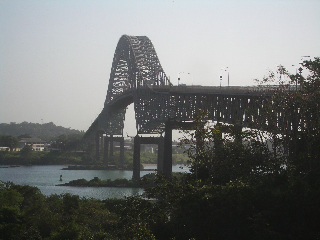
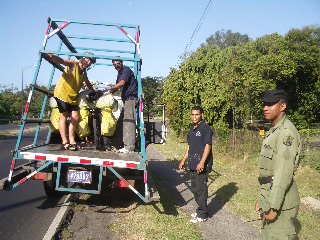
That famous bridge was on our way. However, a stern policeman wouldn’t hear tell of us crossing for fear we’d jump. After a long wait for a police vehicle to escort us across, Kurt lost patience and stuck out his thumb. We were promptly carried across on the back of a truck, much to the bewilderment of the young boy in green.
We followed the Pan American highway which is the main drag east-west in Panama. All other secondary roads lead off to the beaches in the south or the hills in the north, forming a fishbone network.
Instead of just racing through, we decided to spend some afternoons on the beach, where we had the best sunsets,
followed by idyllic camping under a starlit sky,
waking up to the most amazing sunrises.
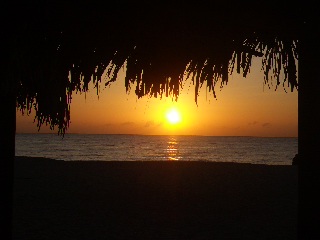
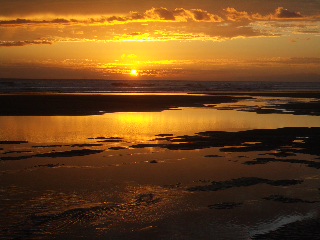
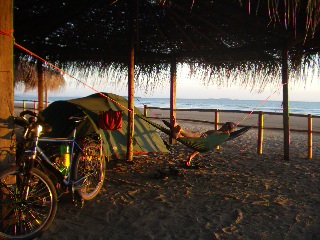
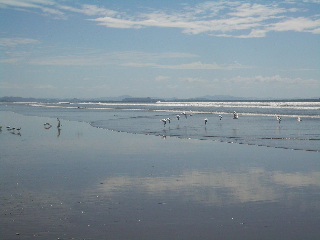
The Pacific coast was refreshing and surprisingly calm, sporting white sand as well as black sand.
The white sand is generally formed from coral, whereas the black sand is of volcanic origin.


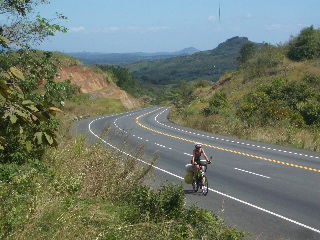
After four days easy cycling we were half way across the country and decided the detours would have to continue or we’d run out of land soon. Panama being just about the size of Ireland makes it easy for cyclists to “do it” in five days. However, our detours showed there’s a lot more to Panama than the Pan-American highway.
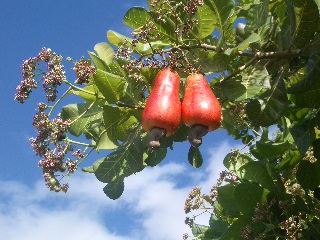
Panamanians have a hello and a wave for everyone and quite a few even speak English. The lack of garden fences give a real sense of security and the absence of armed forces on every corner was very refreshing. There was no shortage of wolf whistles and promises of eternal love from truckers, mostly aimed at Darina!
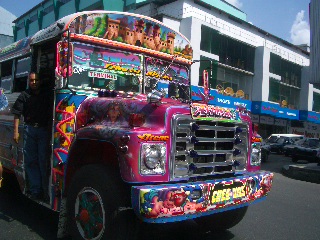
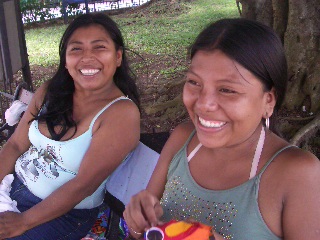
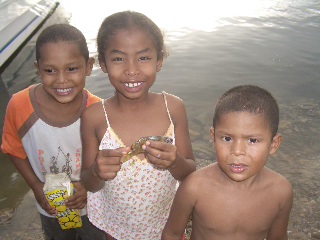
Friendly Panameños
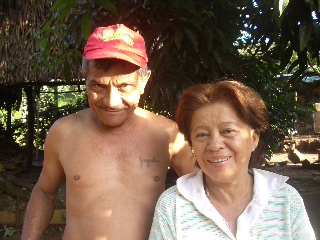
One evening while turning off the main drag in search of a hotel, friendly Evangelista flagged us down and invited us to stay in his house with his wife, Carmen, and family. They showed us to our room, gave us the key of the house and headed off to play bingo for the night! Their good deed and trust resulted in them waking up all smiles the next morning … a jackpot richer!
Panama is becoming a retirement haven for many North Americans. Residential resorts offer all amenities from golf courses to spas and the highway is littered with real estate billboards sporting idyllic condos on the beach. 24-hour funeral services ensure that even your last needs are catered for.
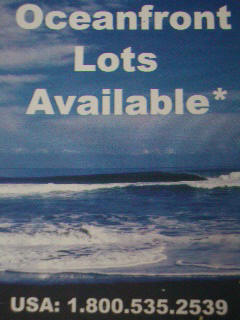

Panama City and the Pacific coast have nine months of rainy season. We arrived nicely to enjoy the mid Dec – mid March dry season. But it came at a price. Temperatures ranging from 35 – 40 degrees Celsius had us on our bikes by 6.30 am most days.
Short before the Costa Rican border we decided to head north into the hills and over to the Caribbean coast again. It sounded like a good idea and so it was for a while. The views of Vulcan Baro were amazing and it was a welcome escape from the 38 degrees below.

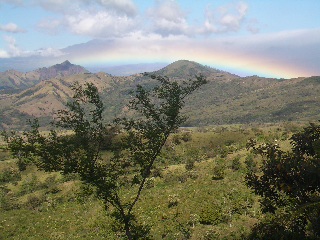
Unfortunately, short before the pass on the Central Dividing Range, we were confronted by a storm that prevented us from advancing in any direction. With power lines down and darkening skies, we were saved from gale force winds and torrential downpours by a local bus.
Bocas del Toro was our next port of call. These 115 islands on the Caribbean, surrounded by coral reefs and mangrove swamps have become quite the backpacker’s hangout. With a rainy season that lasts 12 months, count yourself lucky if you get one sunny day out of five. We had a relaxing few days there, cycling the main island and snorkelling in the Marine National Park.
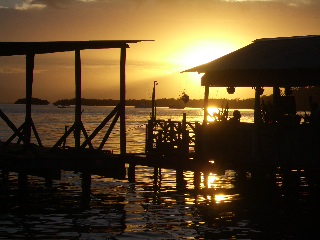
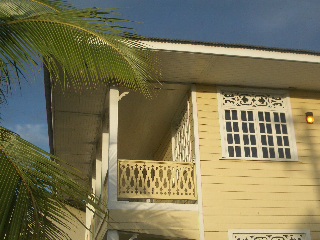

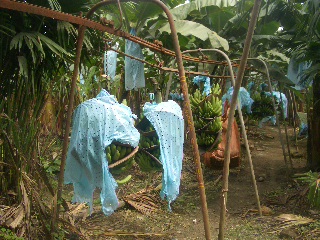
Back on the main land, we cycled through Chiquita Banana plantations and before we knew it we were at the Costa Rican border.
Our three weeks in Panama were thoroughly enjoyable. It was a pleasant change, to have a manageable–sized country, rather than one half the size of Europe! With coral reefs; palm-fringed, white-sand beaches; cool, green highlands; good food; friendly people and courteous drivers, Panama is the business. An excellent destination for a month’s break, even on a bike!
